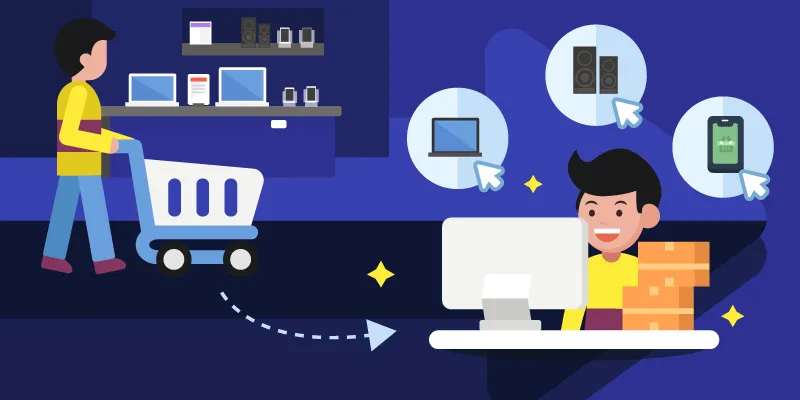The future of retail in an increasingly O2O commerce world
With several interesting M&As happening in the space, it is time to digitise the offline retailer to serve internet-savvy consumers better.
Imagine you’re living in 2025, and the experience of entering a physical store would be a stark contrast to how things are right now. You’d probably be adding items to a virtual cart from an advertisement board. If you feel like experiencing the music quality of your futuristic headphone, then you could search nearby for stores with that headphones. Once you’re content with the quality, scan the product to avail discounts and experience the convenience of delivery at your doorstep. Such transactional touchpoints of the consumer in the offline world are not completely tracked in the current world.

Let’s come back to the present where the big question is:
How to track money spent in the offline world and tap into consumerbehaviour and purchase patterns? The answer is O2O.
What’s O2O?
Online-to-offline commerce, or O2O, is a business strategy/model that finds consumers online and brings them into the realworld to make purchases in physical stores. One aspect of the newer O2O initiatives is the ability to pay online and then pick up a product in a physical location.
In this model,the business treats both channels- online and offline as complementary in terms of increasing sales rather than competitive:
- Products searched and purchased online and picked up from the store.
- Purchasing a product online while being at store. Eg. Suppose you like a pair of trousers at an offline store but you couldn’t find the suitable size or colour, you can simply place an online order while at the store and the product of desired size and colour is delivered to your doorstep.
- Return the product purchased online at a physical location. This strategy incorporates techniques used in online marketing with those used in brick-and-mortar marketing and helps us satisfy the above quest. It is a combination of payment model and foot traffic generator for merchants (as well as a “discovery” mechanism for consumers) that creates offline purchases.
Current advantage of ecommerce over traditional commerce is easy tracking of consumer behaviour, payment information, and easy targeting. O2O will bridge this gap and will make it easy to track the offline transaction and hence enable brands to target consumers directly.
Market size and opportunity
In 2015, e-retail sales accounted for 1.7 percent of all retail sales in India, this figure is expected to reach 4.4 percent in 2019. With the growth of local commerce on the web, the links between online and physical commerce are becoming stronger. By the end of 2018, worldwide ecommerce sales surpassed $2.8 trillion. Around 82.5 percent of all retail sales globally will still happen inside physical stores as late as 2021.
And yet, online sales only represent 11.9 percent of the global retail market. This gap has come to be known as the ‘Trillion Dollar Opportunity’ by media. Businesses that tap into this offline and online gap would have better accuracy in planning their inventory, targeting customer, etc., and would reliably derive more RoI.
Let’s consider an average Indian earns approximately Rs 1,00,000 annually and rarely buys online, considering an average spend of Rs 7,000 annually. Where does the remaining Rs 93,000 go? India has a current population of approximately 1.37 billion and the remaining Rs 93,000 spent by approximately 70 percent of this population is untraceable and not known.
This is where the real opportunity lies. The total ecommerce sales as a percent of total retail sales in India would be close to five percent by 2019. Most of the disposable income is spent locally. You spend money at coffee shops, bars, gyms, restaurants, gas stations, plumbers, dry-cleaners, and hair salons.
Players in the space
Global players like Alibaba in China, Amazon in the US, and Indian players like PayTm, Reliance Jio, Flipkart, Amazon India,etc. are bullish about the market potential and hence the topic of O2O commerce has exploded.
Reliance will be able to do well in India with its hybrid model since it is a deep-pocketed business organisation. The company has over 4,000 outlets owned by them where they sell various items — grocery, garments, and electronics. These 4,000-odd outlets will become the front points for the delivery of ecommerce orders to the customers across India. On top of it, Reliance can and will leverage on the vast presence of Jio’s network across India.
I believe, with their existing infrastructure, Reliance can achieve the depth and width of Walmart, and Flipkart. Shortly, there will be more than one player in a country like India. I expect Amazon, Alibaba through PayTm Mall, Flipkart/Walmart, and Reliance Retail to be among the top four players in the country.
Paytm wants to rope in these local players and help them drive the footfall and sales at their stores. Paytm benefits as these stores in return act as individual warehouses and fulfillment centres. This strategy differentiates Paytm from other ecommerce marketplaces such as Flipkart, Snapdeal, and Amazon, which are pumping in billions of dollars to set up warehouses.
Mergers & acquisitions in the space
Amazon acquired US-based Whole Foods for a staggering $13.7 billion, and Aditya Birla Group’s supermarket chain More. With Walmart buying Flipkart, it is building a hybrid model where they will use Flipkart for the online presence and the Walmart stores for the physical presence. In the UK, Tesco is already doing it. The customer can place his or her order through the Tesco portal and can take delivery of the goods at the nearest Tesco store. In India too, Amazon is doing something similar. Paytm has recently invested in O2O discovery platform Little and hyperlocal service marketplace near.in.
Operational strategy
There are broadly two different strategies to capture the space:
1. Digitising payment acceptance in the offline world
At present, the majority of traditional commerce happens in cash, and hence banks, companies, and lending institutions don’t have a clear visibility of the merchant business. This approach will help the companies access the rich, real-time offline consumer transaction data,and gain clear visibility of merchants’ business and enable themto sell financial products like loan, insurance,etc, to both consumers and merchants. Paytm is the leader in India to enable digital transaction in the offline world.
2. Digitising the traditional commerce supply chain-
The traditional retail brands such as HUL, P&G don’t have the tertiary sale information ie, the end consumer of the product and hence targeting the consumer and visibility of sale and inventory at merchant is less. This approach will help in getting the real-time billing, transaction, coupons, inventory data,etc, and hence enable the brands to reach the merchant optimally. Reliance Jio is taking this approach, as there is news that they have launched a PoS to digitisein-store billing, manage inventory, place order to Reliance CNC, etc.
The future of the business
Considering that 80 percent of consumers research items online before making a purchase, one can see that the future lies in a convergence between online and offline sales. In my opinion, the game in India would change drastically by digitising the offline retailer. With rapid penetration of internet in India, consumers are becoming digital-savvy. The retailers now understand the advantages of the internet for sales and productivity boost.
The low hanging fruit is digitisation of retail supply chain. This will empower the retailers to enjoy the direct discounts from the brands and will also enable brands to get better visibility on tertiary sale and hence will be in a better position to forecast the inventory.
The article was previously published here.
(Disclaimer: The views and opinions expressed in this article are those of the author and do not necessarily reflect the views of YourStory.)







